After years of quiet suffering, American workers are done being silent. The era of revenge quitting has arrived, and it's about to cost businesses everything.
After years of quiet suffering, American workers are done being silent. The era of revenge quitting has arrived, and it's about to cost businesses everything they thought they knew about employee retention.
The workplace rebellion that began with quiet quitting—employees mentally checking out while physically remaining at their desks—has evolved into something far more explosive. In 2025, we're witnessing the emergence of "revenge quitting," a phenomenon where frustrated workers are abandoning the passive resistance of their predecessors in favor of dramatic, vocal departures that send shockwaves through entire organizations.
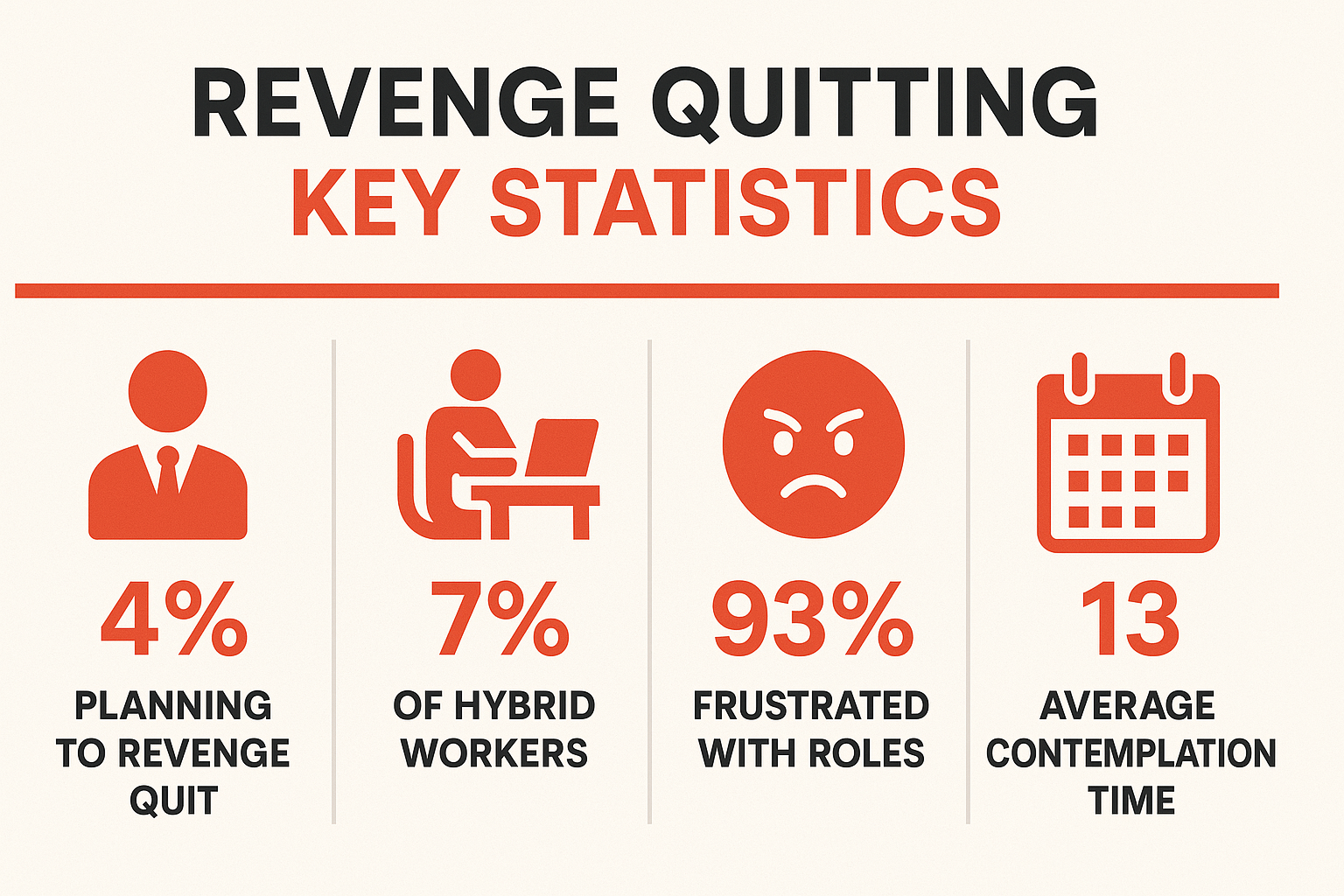
The Death of Quiet Quitting
The numbers tell a story of unprecedented workplace fury. According to the latest research from Software Finder, 4% of full-time employees are actively planning to revenge quit in 2025, with hybrid workers leading the charge at 7%. But these statistics represent only the tip of an iceberg that threatens to sink corporate America. The truly alarming figure lies beneath the surface: 93% of full-time employees report feeling frustrated with their current roles, creating a powder keg of resentment that could explode at any moment.
This isn't merely another workplace trend destined to fade with the next economic cycle. Revenge quitting represents a fundamental shift in the power dynamic between employers and employees—a shift that has been building for over a decade and is now reaching its breaking point. The workers who are planning these dramatic exits have been contemplating their moves for an average of 13 months, suggesting that this isn't impulsive behavior but rather the culmination of sustained workplace trauma.
The timing of this revolution coincides with what Gallup researchers have identified as a catastrophic decline in employee engagement. In 2024, employee engagement in the United States fell to its lowest level in a decade, with only 31% of workers reporting genuine engagement with their work.
The Anatomy of Workplace Rage
To understand the revenge quitting phenomenon, we must first examine the systematic failures that have created this crisis. The primary drivers of employee frustration follow a predictable pattern of organizational dysfunction that has been building for years, finally reaching a tipping point that makes dramatic action feel not just justified, but necessary.
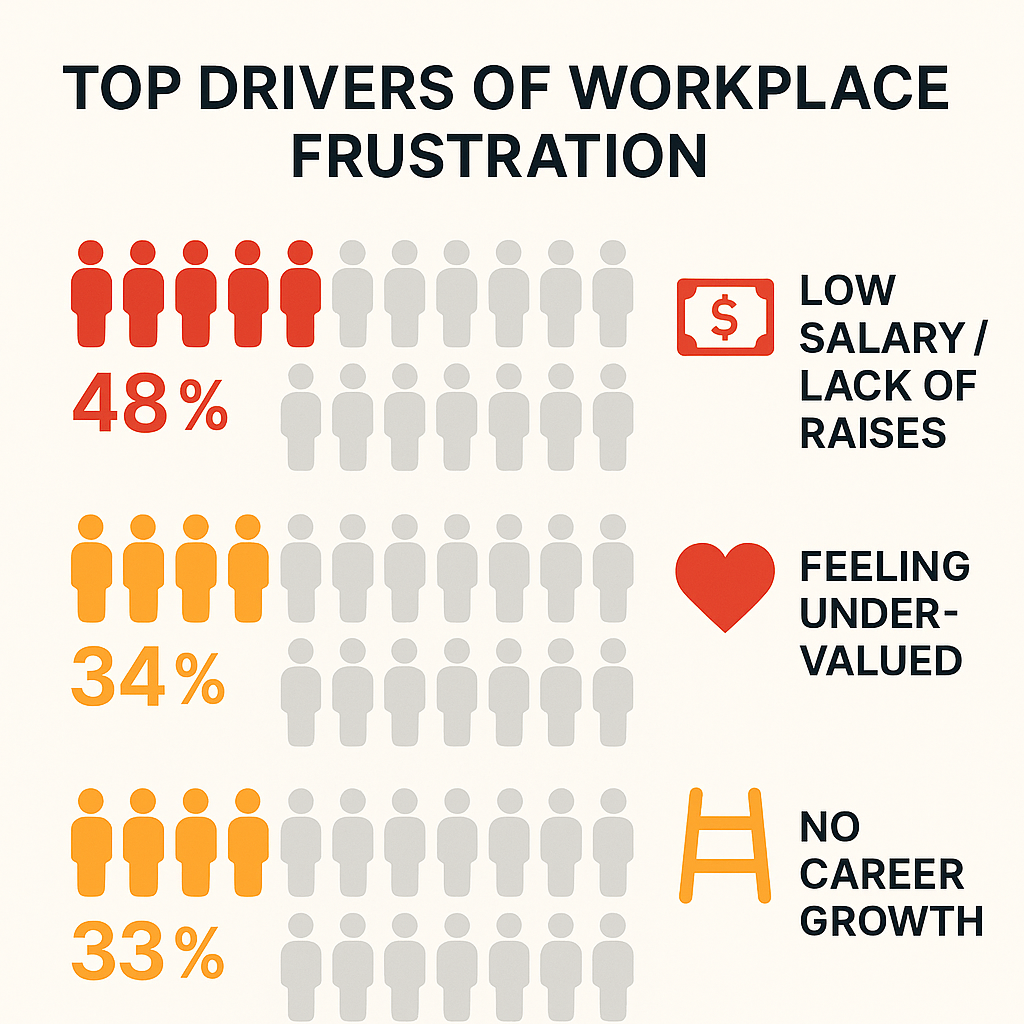
The most significant factor driving revenge quitting is financial frustration, with 48% of workers citing low salaries and lack of raises as their primary grievance. This isn't simply about wanting more money—it's about the fundamental breach of trust that occurs when employees watch their purchasing power erode while their employers report record profits. The psychological impact of working harder for less real income, year after year, creates a sense of exploitation that eventually becomes unbearable.
The second major driver is the feeling of being undervalued, reported by 34% of frustrated workers. This goes beyond compensation to encompass recognition, respect, and basic human dignity in the workplace. When employees feel invisible, replaceable, or unappreciated despite their contributions, the emotional toll accumulates until it reaches a breaking point.
Career stagnation represents the third pillar of workplace frustration, with 33% of workers seeing no prospects for advancement. When employees realize that loyalty and hard work are not being rewarded with opportunities for growth, the psychological contract between worker and employer dissolves.
The $8.8 Trillion Disengagement Crisis
The economic implications of the revenge quitting revolution extend far beyond the immediate costs of employee turnover. According to Gallup's latest research, disengaged employees cost the global economy an staggering $8.8 trillion annually in lost productivity—a figure so large it defies easy comprehension. To put this in perspective, this amount exceeds the entire gross domestic product of every country except the United States and China.
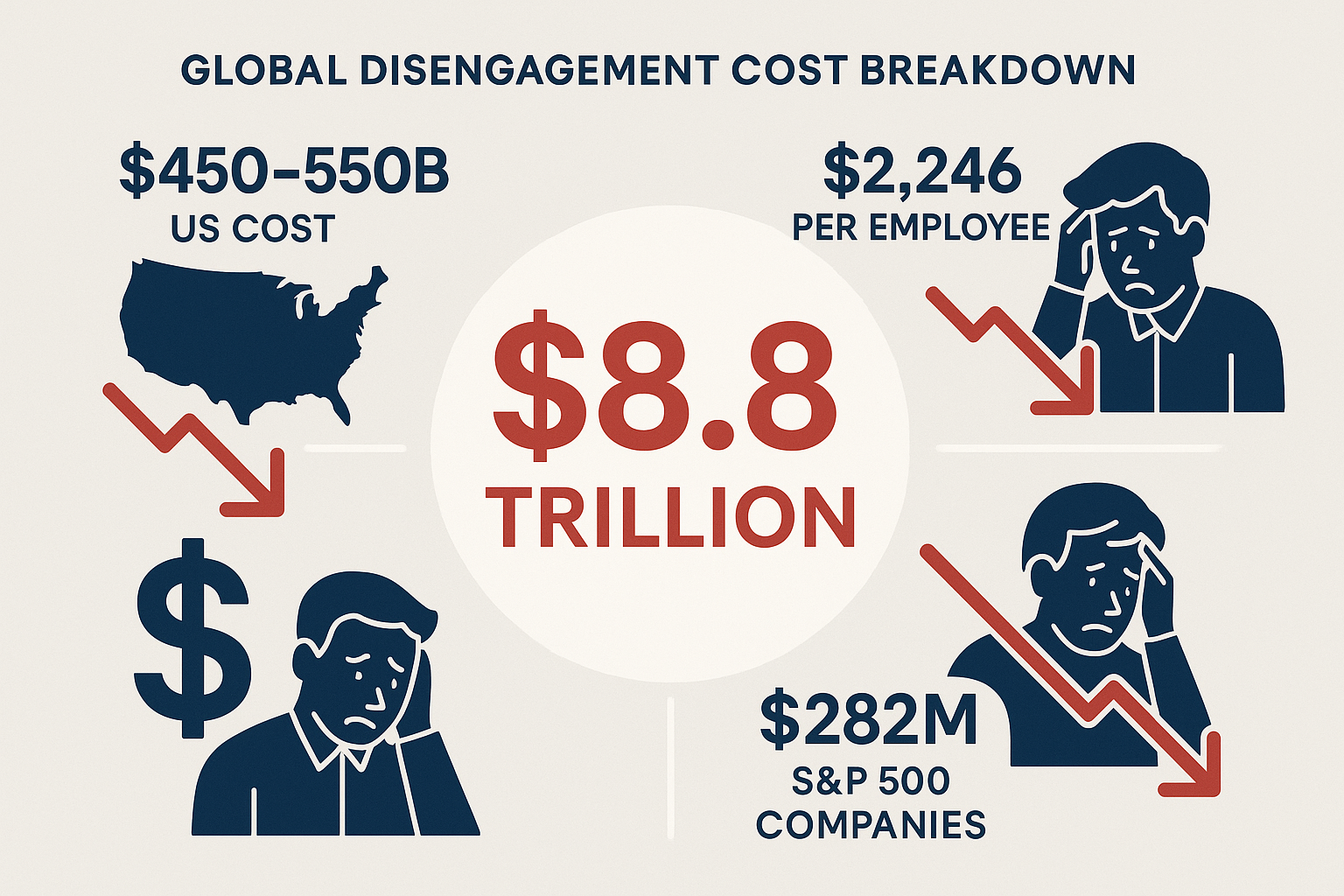
Within the United States alone, disengaged employees cost companies between $450 billion and $550 billion annually in lost productivity. This represents more than the entire federal budget for defense spending and highlights the magnitude of the crisis facing American businesses. The individual cost of each disengaged employee averages $2,246 per year, but this figure only captures direct productivity losses and doesn't account for the broader organizational damage.
For large corporations, the stakes are even higher. McKinsey research indicates that worker attrition and disengagement cost median S&P 500 companies approximately $282 million annually. This figure encompasses not only lost productivity but also the cascading effects of high turnover, including recruitment costs, training expenses, knowledge loss, and the disruption to team dynamics that occurs when experienced employees leave.
The Engagement Collapse: A Decade of Progress Erased
The current employee engagement crisis represents one of the most significant reversals in workplace satisfaction in modern American history. Gallup's tracking data reveals that employee engagement peaked in 2020 at 36%, following a decade of steady improvement that suggested American workplaces were finally learning how to create environments where employees could thrive.
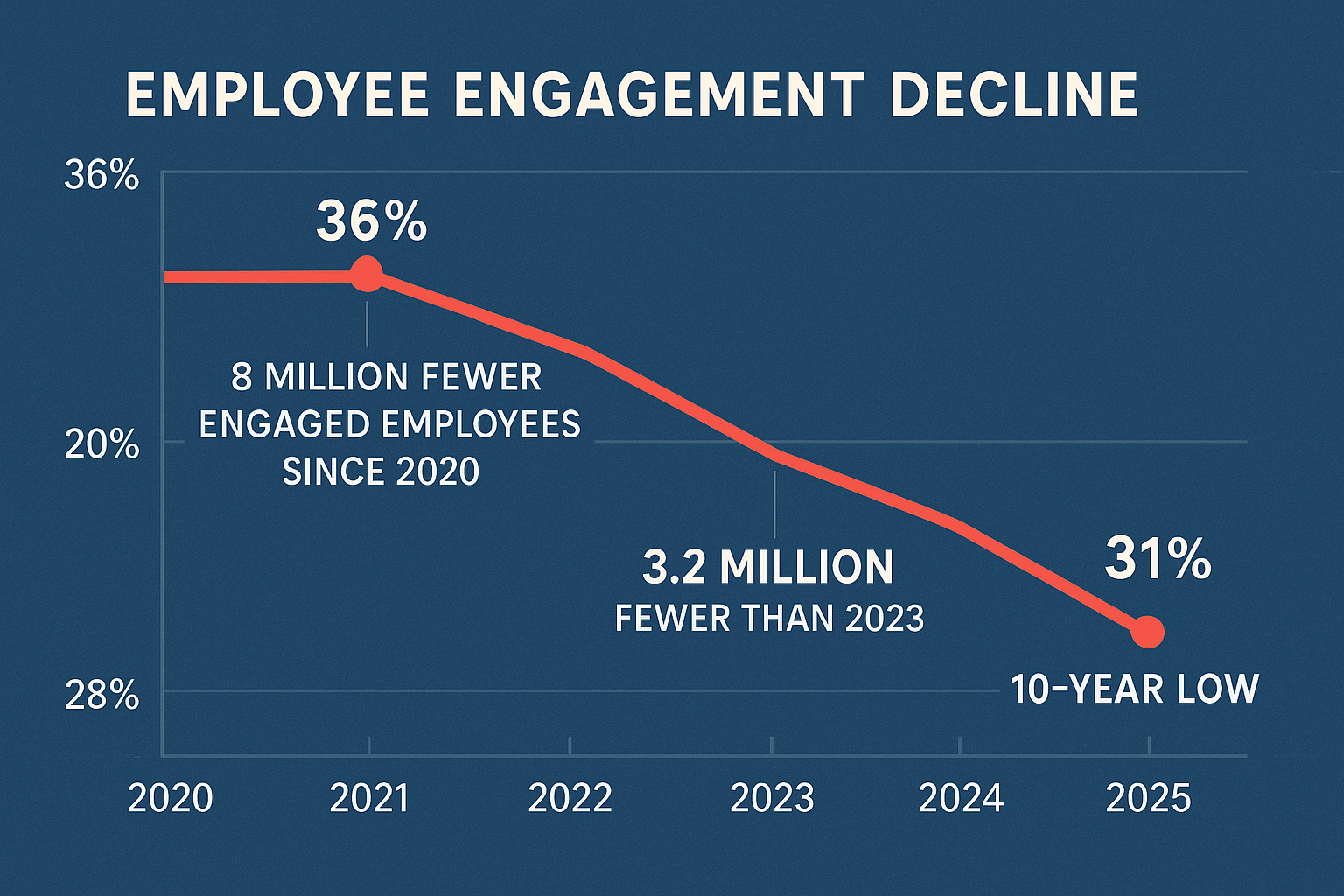
The subsequent decline has been swift and devastating, erasing all progress made since 2014 and leaving organizations scrambling to understand what went wrong. The decline has been particularly pronounced in the fundamental elements that create workplace satisfaction. Only 46% of employees now clearly understand what is expected of them at work, down from 56% in March 2020.
Even more troubling is the decline in workplace relationships and personal connection. Currently, only 39% of employees feel that someone at work cares about them as a person, down from 47% in March 2020. This erosion of human connection in the workplace has profound implications for employee loyalty, job satisfaction, and mental health.
The collapse in developmental support is equally concerning, with only 30% of employees feeling that someone at work encourages their development, down from 36% in March 2020. This decline suggests that organizations have become so focused on immediate productivity that they have abandoned investment in their employees' long-term growth.
Industry Epicenters of the Revolution
The concentration of revenge quitting in specific industries—marketing and advertising, IT and technology, and media and entertainment—reveals important insights about the conditions that foster this phenomenon. These sectors share several characteristics that make them particularly vulnerable to employee rebellion: high-pressure environments, creative workforces, rapid change, and cultures that often prioritize results over employee well-being.
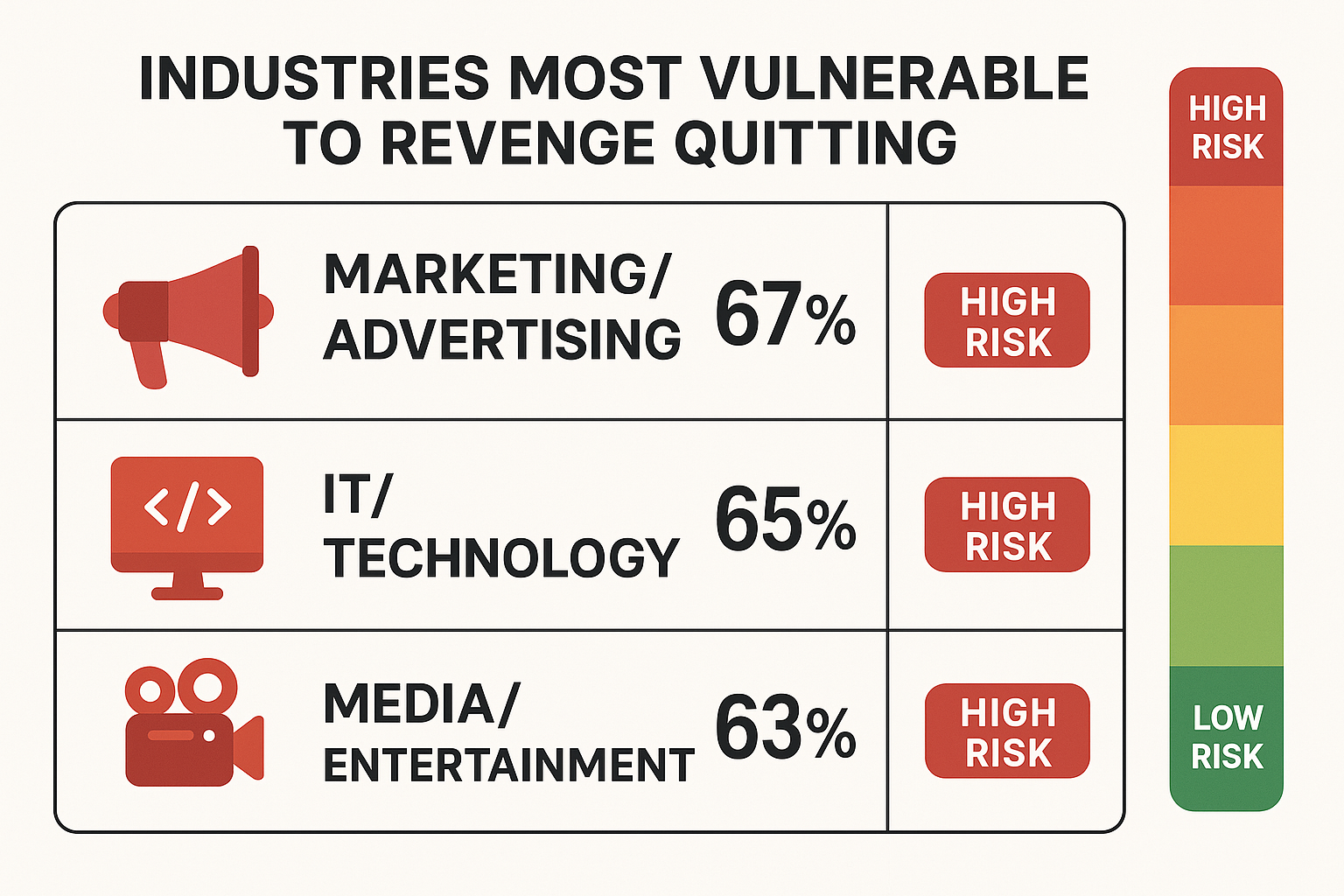
The marketing and advertising industry has long been characterized by demanding deadlines, client-driven chaos, and a culture that glorifies overwork as a badge of professional commitment. The creative nature of the work attracts ambitious, passionate professionals who often enter the field with high expectations for meaningful work and career advancement. When these expectations collide with the reality of endless revisions, impossible deadlines, and limited advancement opportunities, the resulting frustration can be particularly intense.
The technology sector's vulnerability to revenge quitting reflects the unique pressures facing an industry in constant flux. Tech workers often possess highly specialized skills that make them acutely aware of their market value, creating frustration when their compensation or treatment doesn't reflect their worth. The industry's rapid pace of change also creates constant pressure to learn new technologies and adapt to evolving requirements, often without corresponding increases in support or compensation.
The Generational Divide in Workplace Rebellion
The five-point decline in engagement among Gen Z employees represents more than a statistical anomaly—it signals a fundamental disconnect between the youngest workers and traditional workplace structures. This generation entered the workforce during or immediately after the pandemic, experiencing remote work, flexible schedules, and increased autonomy as normal rather than exceptional.
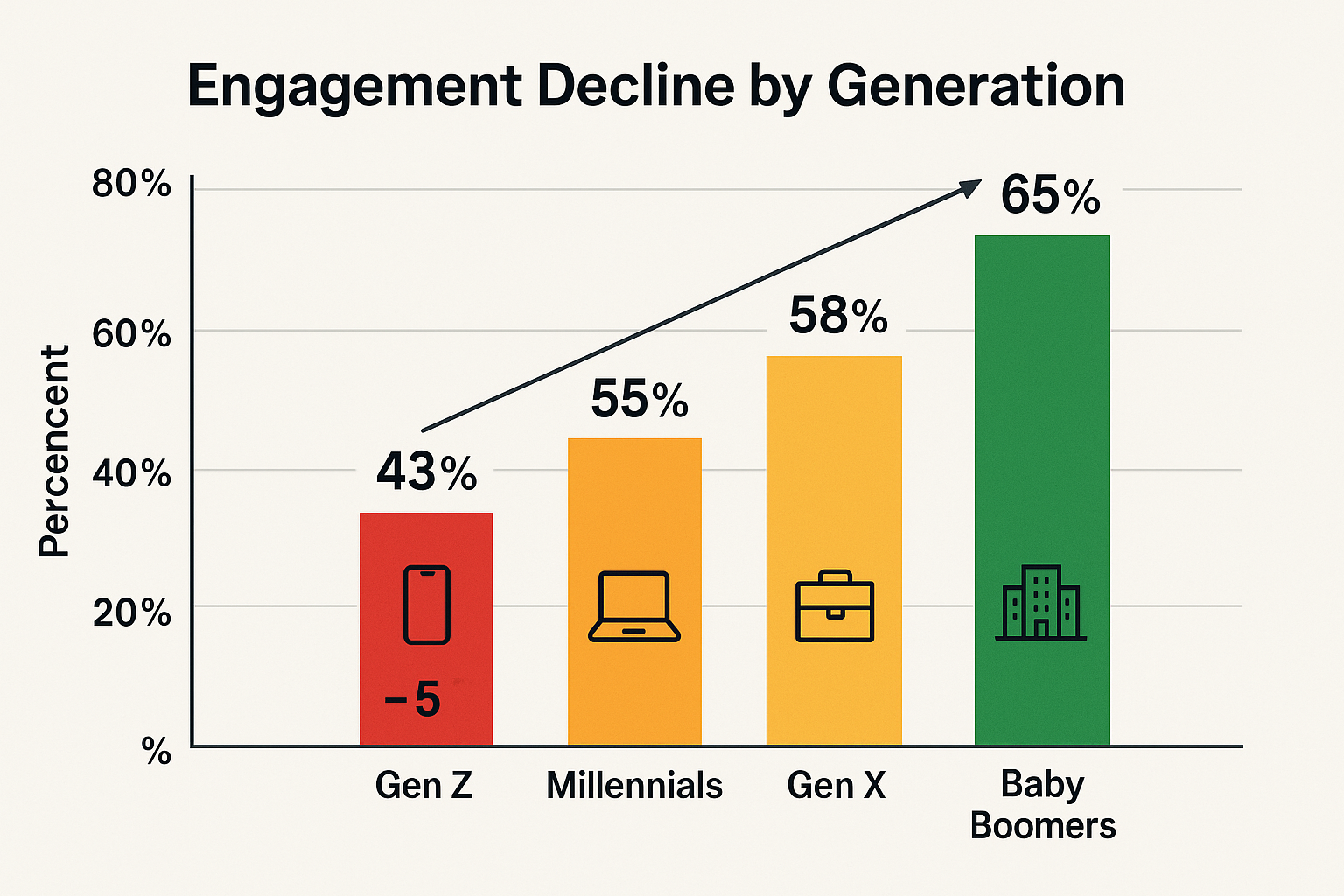
Their sharp decline in engagement suggests that attempts to return to pre-pandemic workplace norms are meeting with significant resistance from workers who have never known traditional office culture as the default. The specific areas where Gen Z engagement has declined most dramatically—clarity of expectations, recognition, access to resources, opportunities to utilize strengths, feeling cared about, and developmental opportunities—reveal the elements of workplace experience that this generation values most highly.
Unlike previous generations who may have accepted unclear expectations or limited development opportunities as normal aspects of early career experience, Gen Z workers appear to have higher baseline expectations for workplace support and investment. This generational difference in workplace expectations creates particular challenges for organizations attempting to manage multi-generational workforces.
The revenge quitting phenomenon among younger workers often takes different forms than among their older colleagues. While experienced workers may leverage their industry knowledge to create maximum disruption, younger workers often use social media and digital platforms to amplify their workplace grievances and departure narratives.
The Economic Uncertainty Paradox
The emergence of revenge quitting during a period of economic uncertainty creates a fascinating paradox that reveals the depth of workplace frustration among American workers. Traditional economic theory would suggest that job insecurity should make workers more cautious about dramatic career moves, yet the revenge quitting phenomenon suggests that many employees are willing to risk their economic security rather than continue tolerating unacceptable workplace conditions.
The current economic context adds complexity to the revenge quitting decision. With unemployment at 4.1% and the number of long-term unemployed (27+ weeks) increasing by 278,000 in December 2024, representing 22.4% of all unemployed people, the job market presents both opportunities and risks. While overall unemployment remains relatively low, the increase in long-term unemployment suggests that finding new employment may be more challenging than in previous years.
The threat of trade wars and broader economic instability creates additional uncertainty that might normally discourage dramatic career moves. However, the willingness of workers to proceed with revenge quitting despite these risks suggests that workplace conditions have become so intolerable that economic uncertainty feels preferable to continued employment under current circumstances.
Stop the Workplace Revolution Before It's Too Late
Don't let your organization become another casualty of the revenge quitting revolution. Learn evidence-based strategies to prevent workplace rebellion and build sustainable employee engagement.
Download the Employee Retention Crisis GuideThe Path Forward: Preventing Workplace Revolution
Organizations seeking to prevent revenge quitting must address the fundamental causes of workplace frustration rather than simply implementing policies designed to make departure more difficult or costly. The research clearly indicates that the primary drivers of revenge quitting—inadequate compensation, lack of recognition, and limited career advancement—are within organizational control and can be addressed through strategic leadership and cultural change.
Conduct regular market analyses to ensure compensation packages remain competitive and implement clear, transparent processes for salary reviews and advancement. The perception of unfairness can be as damaging as actual underpayment.
Go beyond superficial gestures to encompass meaningful acknowledgment of employee contributions. Include day-to-day management practices that demonstrate respect for employee expertise and investment in their success.
Create clear pathways for career progression, provide meaningful development opportunities, and demonstrate genuine commitment to employee growth. Address the professional claustrophobia that often triggers revenge quitting.
Invest in comprehensive management training that goes beyond technical skills to encompass emotional intelligence, communication, and employee development. Managers are failing to provide basic workplace needs.
Cultural transformation may be necessary for organizations that have developed toxic or dysfunctional workplace environments. This requires honest assessment of organizational values, practices, and norms, followed by systematic efforts to create cultures that prioritize employee well-being alongside business results.
The Choice Facing Business Leaders
The revenge quitting revolution represents both a crisis and an opportunity for American businesses. Organizations that respond proactively to address the underlying causes of workplace frustration will gain competitive advantages in talent retention, productivity, and innovation. Those that ignore the warning signs or attempt to suppress employee dissatisfaction through punitive measures risk facing increasingly costly and disruptive workplace rebellions.
The choice facing business leaders is clear: invest in creating workplaces where employees feel valued, supported, and fairly compensated, or continue paying the escalating costs of a workforce in revolt. The $8.8 trillion global cost of disengagement serves as a stark reminder that the status quo is unsustainable.
The emergence of revenge quitting suggests that workers are no longer willing to suffer in silence. The time for fundamental workplace transformation is now, before the revolution spreads and the costs become even more devastating. Those that embrace sustainable, flexible work models will gain access to the best talent, highest productivity, and strongest employee engagement in an increasingly competitive business environment.
The evidence is overwhelming—the question is whether leaders will have the courage to act on it before their own organizations become casualties of the revenge quitting revolution.
References
Nikhil Thakur
About Author
Nikhil Thakur is the creator of BringOnBlog.com, a platform that shares practical insights on business strategy, personal branding, and digital growth. He holds an MBA from SP Jain School of Global Management with international exposure across Europe, Middle-East, and India. Professionally, Nikhil has experience in digital marketing, consulting, and brand storytelling, and has worked across startups and established firms in strategic roles. Through BringOnBlog, he blends global business knowledge with hands-on experience to create content that adds value to modern professionals and entrepreneurs. Connect with him on LinkedIn.




